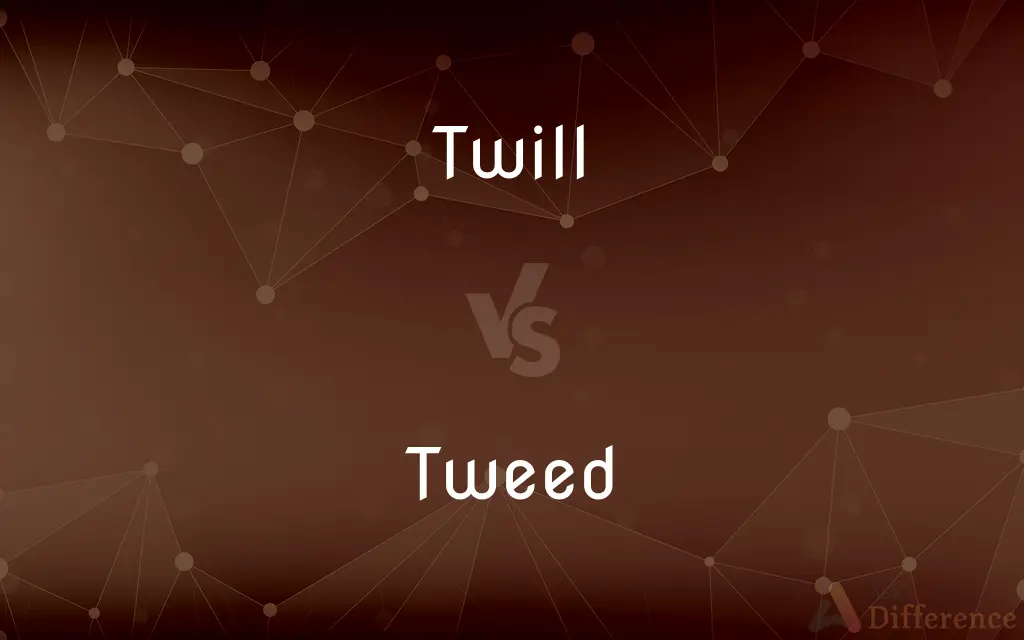Twill vs. Tweed — What's the Difference?
Edited by Tayyaba Rehman — By Maham Liaqat — Updated on March 7, 2024
Twill is a textile weave with diagonal lines, known for durability, whereas tweed is a woolen fabric, celebrated for its warmth and texture.

Difference Between Twill and Tweed
Table of Contents
ADVERTISEMENT
Key Differences
Twill is identified by its diagonal weave or pattern, giving it a distinctive appearance and making it highly durable and resistant to wrinkles and stains. Whereas tweed is a rough, woolen fabric, originating from Scotland, renowned for its warmth, moisture resistance, and durability. It's characterized by its textured appearance, often with flecks of color and is traditionally used in outdoor clothing like sports jackets, coats, and suits, providing both style and functionality in cooler climates.
Twill's structure allows it to drape well, adapting smoothly to body shapes without compromising its form, making it a preferred choice for garments that require a blend of formality and comfort. On the other hand, tweed is bulkier due to its thick, woven structure, providing excellent insulation but with a stiffer drape, which lends itself well to structured garments that hold their shape.
The production of twill involves a specific weaving technique that passes the weft thread over one or more warp threads then under two or more warp threads, creating its characteristic diagonal pattern. This technique not only contributes to the fabric's aesthetic appeal but also enhances its strength and durability. In contrast, tweed is produced through a plain or twill weave but is made distinctive by the woolen yarns that are used, which are often spun with multiple colors and are slightly felted, adding to the fabric's unique texture and color variations.
While twill fabrics can be lightweight to heavyweight, making them suitable for a wide range of climates and seasons, tweed is inherently warmer and heavier, making it particularly suitable for fall and winter wear. This difference in weight and warmth makes each fabric uniquely suited to different types of apparel and different seasonal uses.
Twill and tweed both offer a high degree of versatility and durability, but their distinct characteristics cater to different needs and preferences. Twill's smooth, flexible nature makes it ideal for everyday wear and professional settings, while tweed's rugged, textured look and warmth make it perfect for outdoor activities and cooler weather attire.
ADVERTISEMENT
Comparison Chart
Fabric Type
Woven fabric with diagonal patterns
Woolen fabric with a textured surface
Origin of Use
Diverse use in clothing for its durability and resistance to wrinkles
Traditionally used for outdoor clothing due to its warmth and moisture resistance
Weave
Diagonal weave, contributing to strength and flexibility
Plain or twill weave, with a distinctive rough texture
Material
Made from cotton, silk, wool, etc.
Primarily made from wool, often with mixed colors
Best For
Professional attire, jeans, and comfortable, form-fitting garments
Warm, outdoor wear like jackets, coats, and sports attire
Compare with Definitions
Twill
Versatile in material and use.
She chose a silk twill for her evening gown.
Tweed
A woolen fabric with a rough texture.
His tweed coat kept him warm in the winter.
Twill
A durable fabric with diagonal lines.
The twill jacket resisted wrinkles throughout the day.
Tweed
Offers excellent insulation.
Tweed is my go-to fabric for outdoor adventures.
Twill
Suitable for all seasons.
Lightweight twill shirts are perfect for summer.
Tweed
Traditionally used for country attire.
Tweed caps are a staple in rural fashion.
Twill
Resistant to stains and wear.
His twill pants looked new even after a year.
Tweed
Characterized by its flecked appearance.
The tweed blazer featured subtle green flecks.
Twill
Known for its drapability.
The designer preferred twill for its elegant drape.
Tweed
Ideal for structured garments.
Her tweed suit maintained its shape all day.
Twill
Twill is a type of textile weave with a pattern of diagonal parallel ribs. It is one of three fundamental types of textile weaves along with plain weave and satin.
Tweed
Tweed is a rough, woolen fabric, of a soft, open, flexible texture, resembling cheviot or homespun, but more closely woven. It is usually woven with a plain weave, twill or herringbone structure.
Twill
A fabric with diagonal parallel ribs.
Tweed
A coarse, rugged, often nubby woolen fabric made in any of various twill weaves and used chiefly for casual suits and coats.
Twill
The weave used to produce such a fabric.
Tweed
Tweeds Clothing made of this fabric.
Twill
To weave (cloth) so as to produce a pattern of diagonal parallel ribs.
Tweed
A coarse woolen fabric used for clothing.
Twill
(weaving) A pattern, characterised by diagonal ridges, created by the regular interlacing of threads of the warp and weft during weaving.
Tweed
A soft and flexible fabric for men's wear, made wholly of wool except in some inferior kinds, the wool being dyed, usually in two colors, before weaving.
Twill
A cloth or portion of cloth woven in such a pattern.
Tweed
Thick woolen fabric used for clothing; originated in Scotland
Twill
(transitive) To weave (cloth, etc.) so as to produce the appearance of diagonal lines or ribs on the surface.
Tweed
(usually in the plural) trousers
Twill
To weave, as cloth, so as to produce the appearance of diagonal lines or ribs on the surface.
Twill
An appearance of diagonal lines or ribs produced in textile fabrics by causing the weft threads to pass over one and under two, or over one and under three or more, warp threads, instead of over one and under the next in regular succession, as in plain weaving.
Twill
A fabric woven with a twill.
Twill
A quill, or spool, for yarn.
Twill
A weave used to produce the effect of parallel diagonal ribs
Twill
A cloth with parallel diagonal lines or ribs
Twill
Weave diagonal lines into (textiles)
Common Curiosities
Can twill be made from wool like tweed?
Yes, twill can be made from wool as well as other materials like cotton and silk.
Is tweed suitable for summer wear?
Due to its warmth and heavier weight, tweed is better suited for cooler climates and not ideal for summer.
Can tweed be lightweight?
While tweed is generally heavier, there are lighter variants designed for more versatility across seasons.
What makes twill different from tweed?
Twill is a type of weave with diagonal lines, known for its durability, whereas tweed is a woolen fabric recognized for its warmth and textured appearance.
What are the common uses of tweed?
Tweed is often used for outdoor clothing, including jackets, coats, and suits, due to its warmth and durability.
What is the signature look of tweed?
Tweed is known for its rough texture and flecked color patterns, giving it a distinctive, rustic appearance.
Why is twill considered versatile?
Twill's variety in material and weight makes it adaptable for a wide range of apparel, from lightweight shirts to heavy coats.
How does the weight of tweed affect its use?
Tweed's heavier weight provides excellent insulation, making it ideal for fall and winter garments.
How does the weave of twill contribute to its characteristics?
The diagonal weave of twill enhances its durability, resistance to wrinkles, and gives it a distinctive look.
Why is twill popular in professional attire?
Its resistance to wrinkles and stains, along with its durability, makes twill a preferred choice for professional and formal wear.
Is tweed environmentally friendly?
Tweed, made from natural wool, is considered relatively environmentally friendly, especially if sourced sustainably.
Is twill easy to care for?
Yes, twill's resilience to wrinkles and stains makes it relatively easy to care for compared to more delicate fabrics.
Does tweed require special care?
Due to its woolen content and texture, tweed may require more careful handling and cleaning than some other fabrics.
Are there different types of twill?
Yes, there are several types of twill, including herringbone and houndstooth, each offering a unique diagonal pattern.
What occasions are suitable for tweed attire?
Tweed is perfect for outdoor events, casual settings, and traditional occasions, especially in cooler weather.
Share Your Discovery

Previous Comparison
Cranberry vs. Barberry
Next Comparison
Choppy vs. ChappyAuthor Spotlight
Written by
Maham LiaqatEdited by
Tayyaba RehmanTayyaba Rehman is a distinguished writer, currently serving as a primary contributor to askdifference.com. As a researcher in semantics and etymology, Tayyaba's passion for the complexity of languages and their distinctions has found a perfect home on the platform. Tayyaba delves into the intricacies of language, distinguishing between commonly confused words and phrases, thereby providing clarity for readers worldwide.














































